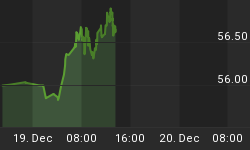The broad market averages are about to encounter their first real resistance point this week - the 1/3 retracement level of the October high and January low. They are also running into the November lows. I've read a lot of commentary this weekend from people who think the market is likely to top out at the November lows. They see a big resistance area between the 1390 and 1425 level on the S&P 500. They're right about this. In fact 1425 would be about a 50% retracement level of the October high and January low and often 50% retracement levels are where countertrend moves come to an end. However, I think this rally has farther to go then that.

When the market was bottoming I had a 1450 target level for the S&P 500. When I went long I was using that as a rough estimate to figure out my risk to reward for my positions, but the market is likely to go even higher than that. On January 25th I wrote an article titled How This Rally is Likely to Unfold. In it I examined past bear market countertrend rallies, such as those in the 2000-2002 bear market, to see how this one is likely to play out. In all of those prior bear market rallies the market rallied back up to its 150 and 200 day moving averages.
Such a move now would take the S&P 500 up to the 1460-1500 area. Not coincidently 1460 is the 2/3's retracement level and also is where the downtrend resistance line connecting the highs of October, November, and December is now sitting. We should expect the market to rally a minimum to these levels, with the odds now favoring a move up to the 200-day moving average. In fact it is possible for the market to rally 2-3% above its 200-day moving average to make a climatic top if the market consolidates around its 200-day moving average and then makes an exhaustion rally.
Once this rally ends - and I see it ending sometime in March or early April - I expect to see another bear market decline of worse magnitude than this last one that will take the S&P 500 down to the 1178 level. This would be a 25% correction from its October high. BMO Capital Markets put out an excellent study showing that 25% is the historical bear market decline during economic recessions.
They found that "since 1950, there have been eight official recessions in the US lasting an average of 10 months. Stocks peak 10 months before the recession begins, reflecting expectations of slower economic and earnings growth, and fall an average of 26% to their trough, which occurs about three fourths of the way through the recession."
Of course it could be that in the end this bear market ends up being one as large as the one between 2000 and 2002. The Fed's Mishkin study (see page. 38) projects the bear market in real estate continuing through 2009 and this recession lasting until 2010, with a trough in the business cycle being made in the first half of 2009 as real estate bottoms out!
The farther you try to project into the future the more unreliable your projections are going to be. I'm not sure what the market is going to do at the end of this year. All I know now is that I see this current rally going further from here and then another bear decline taking place once it is over.
But I think at the moment I'm actually more bullish than most people. There is still a lot of skepticism over this rally. Last week's Investors Intelligence numbers showed an increase in the number of bears and decline in the number of bulls despite the fact that the market bottomed the week before and we already saw a nice lift off of the lows.
It is going to take weeks to get the Investors Intelligence numbers into a position where people are bullish enough that we can look for a top from a contrarian standpoint.
Combine this with the fact the market had reached technical oversold levels not seen since the bottoms made on September 11th or in the Fall of 1998 and there is every reason to think this rally is going to go on for more than just two weeks - and will go on long enough to trap everyone into becoming bullish at the top.
Those trying to pick a top in a matter of days need to think in terms of weeks.

I use TC2007 to study the market and find stocks to buy. TC2007 breaks the market up into 239 sectors so that I can track how the sectors behave relative to the rest of the market and each other. The above is a sort of the performance of the sectors since the market bottom. What you see above are the very top performing sectors. Most of them are related to real estate construction, banks, transportation, and lending institutions, including savings and loans and credit services.
These are the very sectors that were leading the market to the downside since October. This is the classic signature of a bear market rally. Countertrend rallies in bear market are usually led by the groups and stocks that have fallen the most, because their rallies are fueled by heavy short covering. At the end of bear markets leadership tends to shift into different sectors - sectors that end up leading in the first three innings of the next bull market, but as long as the bear market continues countertrend rallies will be led by the sectors that dropped the most during the declines.
Fore more sign up for our free weekly newsletter, with a focus on gold stocks and weekly commentary on the stock market. Just click here.















